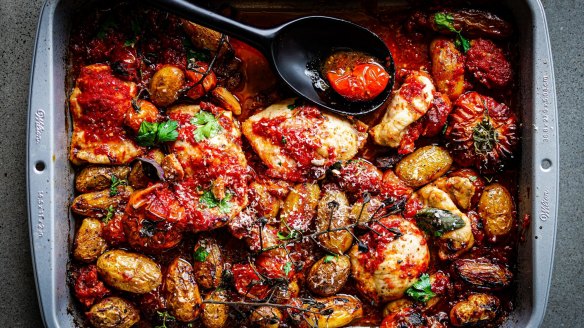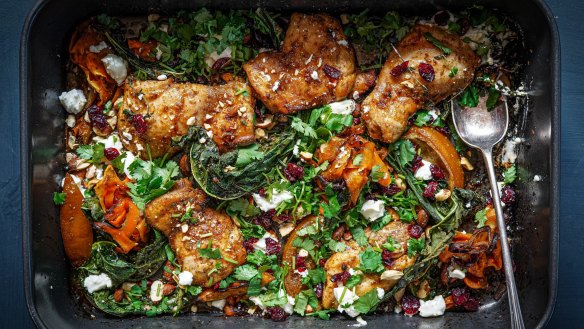Why chicken thighs and quarters are the best poultry cuts you can buy (and how to cook them)

- 60+ ways to make the most of chicken thighs
- 20 cheap and cheerful chicken maryland recipes
- Katrina Meynink's chicken amatriciana traybake
While developing a recipe for chicken, I put out a call on Twitter to get a sense of how various people prepare it in their own kitchens. I asked about things such as what vegetables they include and which cut of chicken they prefer to use. To the latter, food blogger Marta Rivera Diaz replied: "Dark meat because I actually love myself." And never have I agreed more.
The Western world has an obsession with white meat, particularly boneless, skinless chicken breasts, favouring them for the ease and efficiency with which they can be cooked and consumed. Additionally, the lack of skin and bones helps people dissociate from the fact that the food they're consuming was once a living, breathing animal, supporting their cognitive dissonance around wanting to consume meat with as little involvement as possible in the process.
Well, it's time to escape the chicken breast chokehold and embrace more flavourful and forgiving cuts of fowl: chicken quarters and thighs. (While much of the following applies to drumsticks as well, their stringy tendons and high bone-to-meat ratio make them less versatile as the sole cut of chicken in recipes.)

For starters, dark meat simply has more flavour thanks to its higher fat content – and in my kitchen, flavour reigns supreme. (If you are concerned about your fat intake, you can trim or completely remove the skin.) If speed is what you're after, anything boneless, skinless chicken breasts can do, boneless, skinless chicken thighs can do better. The two are interchangeable in recipes, allowing you to enjoy the same efficiency you're used to with breasts. And in addition to quick-cooking dishes, thighs and quarters have the versatility to stand up to longer cooking methods, such as braising, meaning you can do more with these cuts.
Chicken quarters and thighs also have a significant price advantage, being comparatively cheaper in countries such as the US.
It's also easier to cook dark meat so that it remains tender and juicy. The US Department of Agriculture's guidance for the minimum internal temperature – 75C (as measured with a meat thermometer), at which point harmful bacteria is killed instantaneously – already surpasses the level at which professional and highly experienced home cooks prefer for white meat.
Chef and cookbook author J. Kenji Lopez-Alt prefers chicken breasts cooked to 63C, but acknowledges the texture isn't for everyone. "As long as chicken stays at 65C or higher for at least 2.7 minutes, it is as safe to eat as chicken that has been cooked to 75C," he wrote in The Food Lab cookbook. The team at Cook's Illustrated prefers 70C – "the test kitchen's favourite temperature for juiciness and tenderness," per the Cook's Science cookbook – where it needs to be held for only about 50 seconds to kill salmonella and be safe to consume.
"Despite government warnings to be sure to cook chicken to 75C, in reality, about 65C or so, muscle fibres have become almost completely squeezed dry," Lopez-Alt wrote. "Congratulations, your dinner is now officially cardboard."
But the story for dark meat is a cook's dream. Although the USDA's recommended temperature at which it's safe to consume is the same, dark meat's texture is actually better at higher temperatures. "Unlike chicken breasts, chicken thighs and drumsticks actually become more tender the longer they cook," Mari Levine of America's Test Kitchen explains. "Dark meat has an abundant amount of connective tissue, which dissolves into gelatin as the meat cooks, rendering it juicy and tender. The longer it cooks, the more that connective tissue breaks down." This means that chicken thighs are good at an internal temp of 80C, but they're even better at 90C, she says.
However, there is an upper limit. Once dark meat chicken hits 100C, the flavour and texture start to deteriorate. So while you can get chicken thighs that are safe to eat in as little as 30 or 40 minutes in the oven (depending on the temperature), a quick experiment at home showed that it took over an hour for it to reach 100C (at which point the thighs were still edible, but definitely a little stringy). That's at least 20 minutes of wiggle room! In a world full of distractions, ingredients with flexibility built in are priceless.
The Washington Post